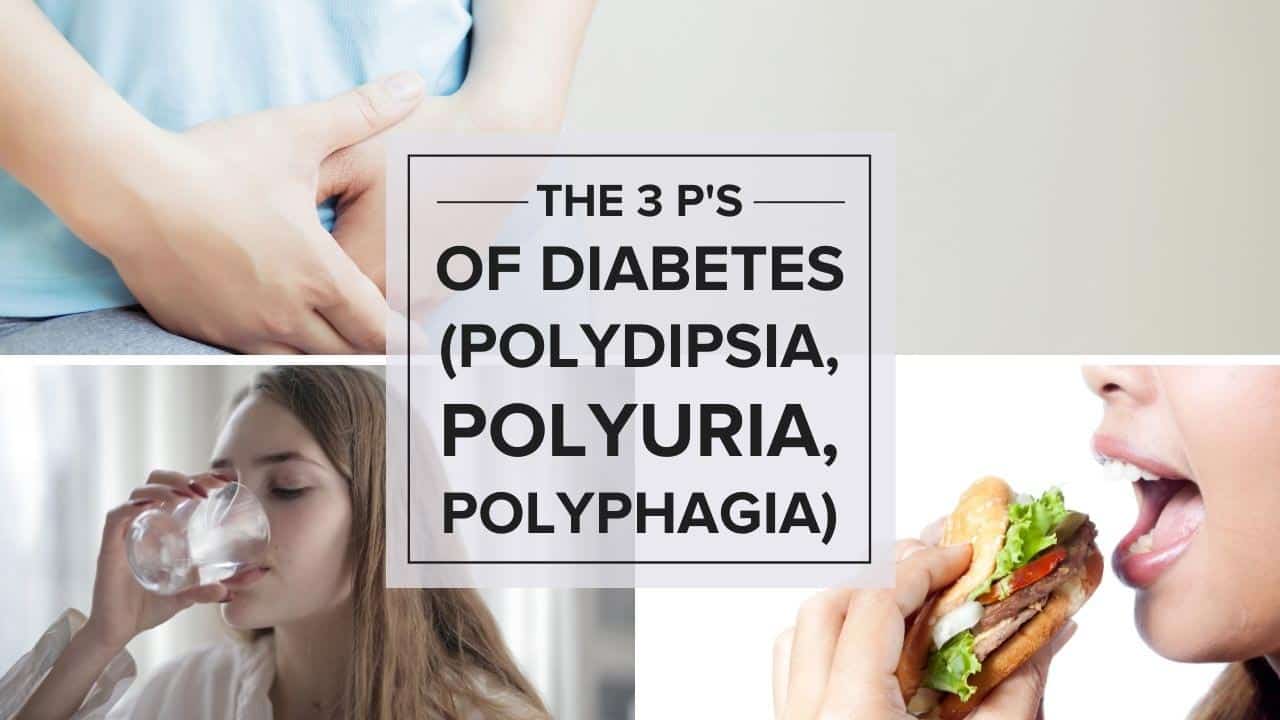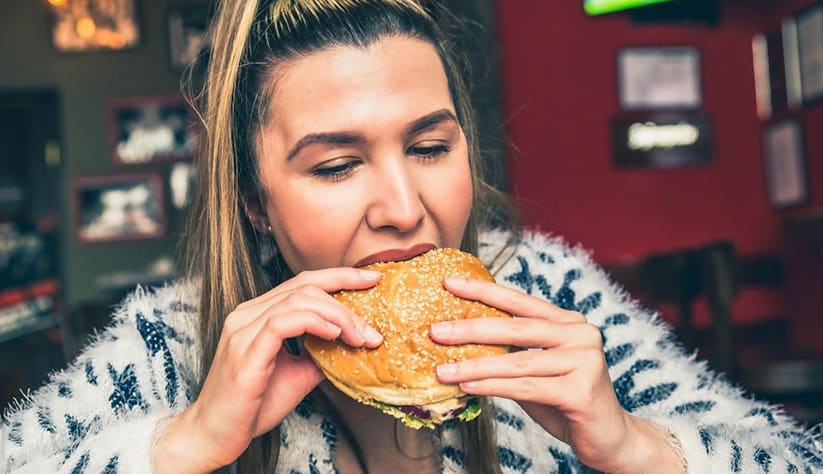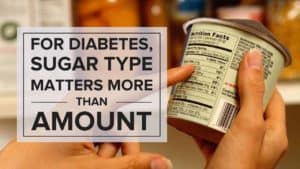
What Are The 3 P's Of Diabetes?
The three P’s of diabetes are polyuria (excessive urination), polydipsia (excessive thirst), and polyphagia (excessive hunger), which are the three most common early warning signs of type 1 diabetes mellitus and type 2 diabetes mellitus.
When your blood glucose levels are too high, the excess glucose affects the regular performance of your endocrine system, which in turn affects your temperature sensitivity, appetite, and thirst.
Identifying the signs of diabetes early can be incredibly important to treating these conditions, as quick intervention can help to either reversing the condition (in the case of type 2 diabetes) or preventing health complications (like in type 1 and type 2 diabetes).
In this article, we’ll explore each of the three P’s of diabetes in detail, and explain what you can do if you experience any of these three conditions.
Polyuria

Polyuria, which translates roughly to excessive urination, is defined as urine output exceeding 3L/day in adults and 2L/day in children.
There are 3 major reasons this excessive and frequent urination can occur: psychiatric reasons, chronic kidney disease, or complications related to diabetes. In this article, we’ll focus on how diabetes can cause polyuria.
What Causes Polyuria?
In individuals with type 1 and type 2 diabetes, either very high insulin resistance (due to dietary fat) or an autoimmune condition that attacks insulin producing cells leaves your body unable to successfully process blood glucose (blood sugar).
This, in turn, causes there to be excess glucose in your blood. During the natural process of urination, your kidneys remove extra glucose (and other metabolites) from your blood and sends them to your bladder to excrete in urine.
Very high levels of glucose in your blood means that your kidneys are forced to work harder to remove that excess glucose, resulting in excessive urination known as polyuria.
In simple terms — normal blood glucose leads to normal urination. Excessive blood glucose leads to excessive urination.
Polydipsia

Polydipsia is the excessive consumption of water and other fluids, sometimes referred to as "diabetes increased urination," which is almost always accompanied by the presence of excessive thirst and dry mouth that seem like they won’t go away no matter how much water or fluid intake you have.
There are actually two types of polydipsia: psychogenic polydipsia, which results from psychiatric conditions, and dipsogenic polydipsia, which results from endocrine changes.
The type of polydipsia faced by people with diabetes is dipsogenic polydipsia, which we’ll focus on in this article.
What Causes Polydipsia?
Then break down these symptoms to their causes. What’s happening on a scientific level?
In many cases, the root cause of dipsogenic polydipsia, meaning from endocrine changes, is high blood glucose levels (high blood sugar levels). As we explained above, if your endocrine system detects excess glucose in your blood, it signals to your kidneys to expel this extra glucose through extra urination.
However, the whole time that you’re producing elevated levels of urine, your kidneys are depleting your body’s natural levels of fluids. In response, your endocrine system also signals to your brain that you’re thirsty, to help signal you to drink water and replace the missing fluids.
However, if the underlying cause of this elevated blood glucose (whether that’s type 1, type 2, or any other form of diabetes) is not dealt with, this constant process of excessive urination followed by excessive thirst continues.
Polyphagia

Let's start with a simple, easy-to-understand polyphagia definition. When translated directly, you define polyphagia as overeating, and usually corresponds to an overpowering or excessive hunger.
In contrast to normal hunger, polyphagia doesn’t go away even when you eat a normal or even excessive amount, and is one of the oldest signs of identifying diabetes.
Much like the other P’s of diabetes, there can be other psychological and physical causes of polyphagia (like hypoglycemia, anxiety, or eating disorders), but this article will focus on how diabetes can cause polyphagia.
What Causes Polyphagia?
Type 1 diabetes and type 2 diabetes both cause polyphagia in different ways.
Polyphagia in Individuals with Type 1 Diabetes
In people with type 1 diabetes, your pancreas loses its ability to produce sufficient insulin. Insulin is the hormone that signals to your cells to accept glucose from your blood, so without it, your cells don’t receive the energy they need.
Because your cells aren’t receiving the energy they need, they signal to your brain that they need more energy, which triggers the hunger response.
But since your pancreas is still unable to produce insulin, this continued eating without additional insulin can only lead to dangerous blood glucose levels.
For this reason, polyphagia can actually be the most dangerous of the 3 P’s of diabetes.
Polyphagia in People with Type 2 Diabetes
In people with type 2 diabetes, the cause of hunger is different, but the results are equally (if not more) dangerous.
Type 2 diabetes is caused by insulin resistance, in which the accumulation of excess dietary fat in tissues that are not supposed to store large quantities of fat hinders the action of insulin. Basically, your body is still able to produce insulin but your cells are not responding to it.
However, the results are similar as with type 1 diabetes. Cells in your muscle and liver don’t receive enough energy (despite the fact that you have high blood sugar), and signal the hunger response, which continues to increase your blood glucose levels.
The additional risk with type 2 diabetes is that this excessive eating can also worsen your insulin resistance in the process. In simple terms, for people with type 2 diabetes, polyphagia can worsen both the causes and the effects of your condition.
Other Diabetes Symptoms To Watch For
Many doctors point to the 3 P’s as the most direct indicators of diabetes, but there are a number of other symptoms to watch out for.
For both forms of diabetes, diabetic retinopathy (visual disturbances) and diabetic neuropathy (mental disturbances like confusion) can also be present. Fatigue is also a common side effect of both forms of diabetes, as well as slow-healing sores and wounds.
Type 1 diabetes also tends to be associated with unexplained weight-loss, while type 2 diabetes often corresponds with a tingling in the hands and feet.
You can learn more about these symptoms and their differences here.
When You Should See A Doctor
Provide insight to your readers on when and why someone should see a medical professional. Give them resources outside of just their primary care physician as well.

We recommend going to see a doctor if you experience any of the 3 P’s, as well as the common symptoms of diabetes listed above.
For diabetic patients, identifying these conditions quickly can provide the time to intervene and return your blood glucose levels (blood sugar levels) to a safe level before they cause more complications like high blood pressure, diabetic ketoacidosis, or worse.
Disclaimer: Always trust your physician’s advice when considering seeking out emergency care. These guidelines are general, but cannot replace the personalized knowledge of a trusted care provider.
The Importance Of An Early Diagnosis
As we mentioned above, identifying diabetes in all its forms early can be crucial to preventing complications like hyperglycemia (high blood glucose), hypoglycemia (dangerously low blood sugar levels), diabetic ketoacidosis (DKA), high blood pressure, and other dangerous complications.
Also, quickly seeking out medical advice can be incredibly valuable to treatment for these conditions.
For example, if caught early enough, type 2 diabetes and prediabetes can be effectively reversed by reversing the underlying insulin resistance that causes them.
And in the case of type 1 diabetes, quickly intervening and making sure that you get enough insulin can be the key to controlling your high blood glucose, and beginning to build the habits and dietary decisions that will help you return to a normal, healthy life.
You can learn more about the early indicators and risk factors of type 1 diabetes and type 2 diabetes by clicking on each link.
And if you’re already living with any form of diabetes, but still struggling to prevent it from taking over your life, we have a number of resources throughout this website that can help you take back control.
Stop Guessing What to Eat
Get Delicious Recipes Sent to Your Inbox Every Week!

Discover the custom-designed Weekly Meal Plan that gives you clarity on what to eat and how to shop to simplify your journey to lower blood sugar, weight loss, and your best A1c




